Europe FMCG Logistics Market Size
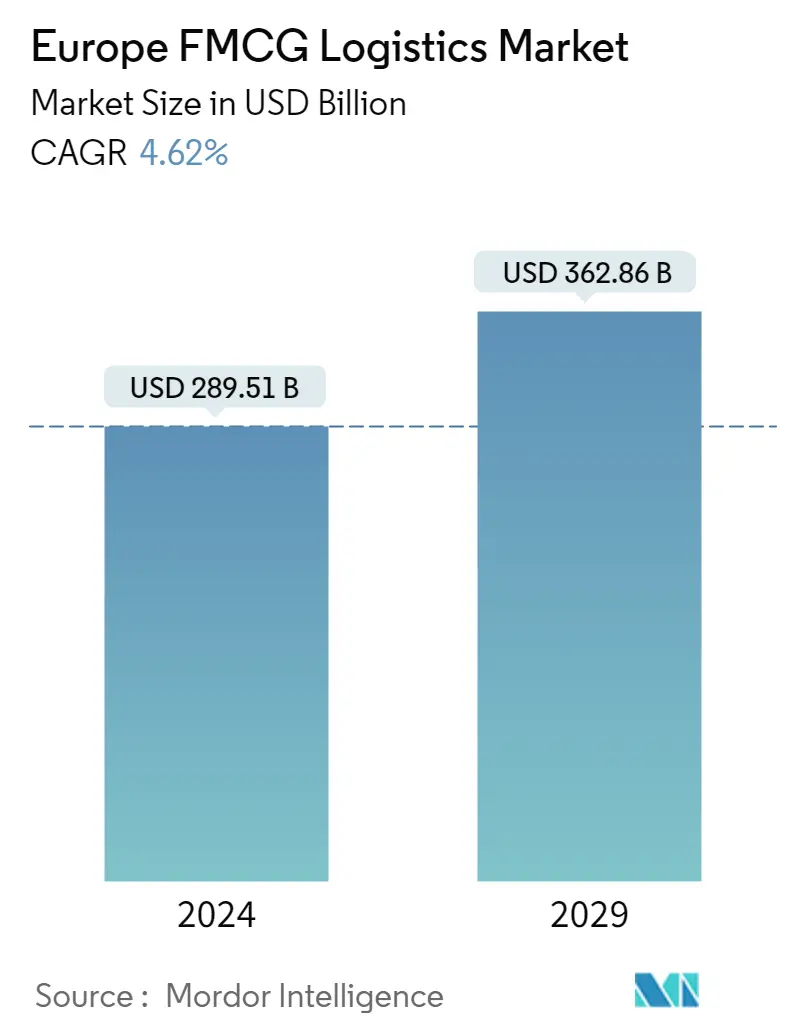
| Study Period | 2020 - 2029 |
| Base Year For Estimation | 2023 |
| Market Size (2024) | USD 289.51 Billion |
| Market Size (2029) | USD 362.86 Billion |
| CAGR (2024 - 2029) | 4.62 % |
| Market Concentration | Low |
Major Players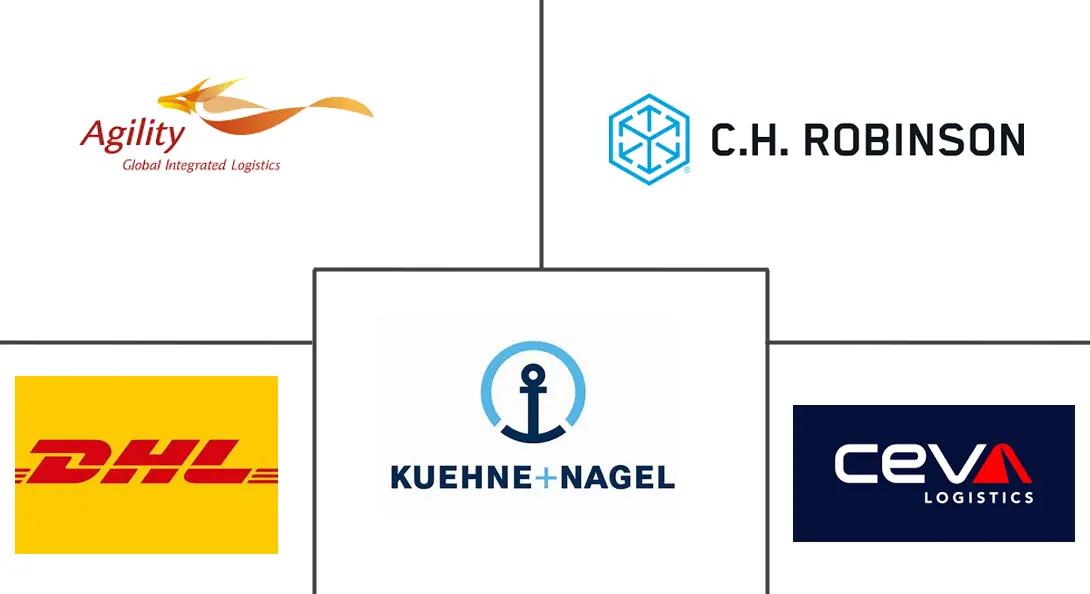
*Disclaimer: Major Players sorted in no particular order |
Europe FMCG Logistics Market Analysis
The Europe FMCG Logistics Market size is estimated at USD 289.51 billion in 2024, and is expected to reach USD 362.86 billion by 2029, growing at a CAGR of 4.62% during the forecast period (2024-2029).
The COVID-19 crisis fundamentally disrupted the demand and supply in the European road freight market. While virtually all of Europe was affected, the impact had distinct phases. The effects of lockdowns and border crossing restrictions evolved as time passed and the market adjusted to the government's new rules.
Logistics investments in Europe went up to EUR 45.62 billion (USD 47.60 billion) in 2021, driven by the massive e-commerce growth in Europe. Key parameters promoting market growth include economic growth, increasing population, and industrialization. However, the lack of the government's commitment to developing seaports or road networks and reconfigured supply chains, with the growing local production and consumption units, are hampering the market growth.
Western Europe had the largest market share in the FMCG logistics market in Europe in 2020, and the region will offer several growth opportunities to market vendors during the forecast period. Increasing M&A in the logistics industry, growing focus on truck platooning by logistics vendors, and increasing adoption of sharing economy will significantly influence FMCG logistics market growth in this region.
Europe FMCG Logistics Market Trends
E-commerce Sales to Rise at a High Pace in Europe
Numerous e-commerce businesses witnessed more significant operational expansion even though they functioned on a shoestring initially. Third-party logistics allows retailers to unleash greater sophistication before their customers on the deals made through the e-commerce mode. According to industry experts, e-commerce will likely account for 25% of the total retail sales in the United Kingdom by 2023. In Western Europe, 10.2% of retail sales are online, while 5.0% are online in Eastern Europe. With only around 5% of the total retail sales currently made online in Spain and Italy, these two markets are expected to see the most substantial online retail sales growth of all the Western European markets over the next five years at 17% per annum and 21% per annum, respectively. Likewise, Central and Eastern Europe may witness an average growth of 17.5% annually, with Romania, Russia, and Hungary performing the strongest.
France and Italy are highly established premium markets that contribute to significant shares in the European market. More and more healthcare and pharmaceutical companies are entering the e-commerce world. As a result, they find themselves attempting to identify the most suitable way to meet ever-burgeoning demand while dealing with numerous regulatory restrictions. While wellness and beauty products, such as nutrition supplements and cosmetics, may be sold online with few regulatory restrictions (although there are still several critical requirements to inform potential consumers about the characteristics of the products and their prices), e-commerce of medicines is subject to considerably more conditions.
In some cases, legislation absence raises questions and creates a high uncertainty level for those considering entering the e-commerce field (e.g., those in the medical device industry). At the same time, authorities continue to enact oversight and enforcement. There are frequent reports of websites that are banned because they offer prescription-only medicines or even illegal medicines to Italian consumers (this includes websites operating abroad). Spain is the 13th largest market for e-commerce, with a revenue of USD 27.2 billion in 2021, placing it ahead of Italy and Russia. With an increase of 17%, the Spanish e-commerce market contributed to a worldwide growth rate of 15% in 2021. Like in Spain, global e-commerce sales are expected to increase over the following years. As new markets emerge, global growth will continue over the upcoming years. East and Southeast Asia will propel this development with their growing middle class and lagging offline infrastructure.
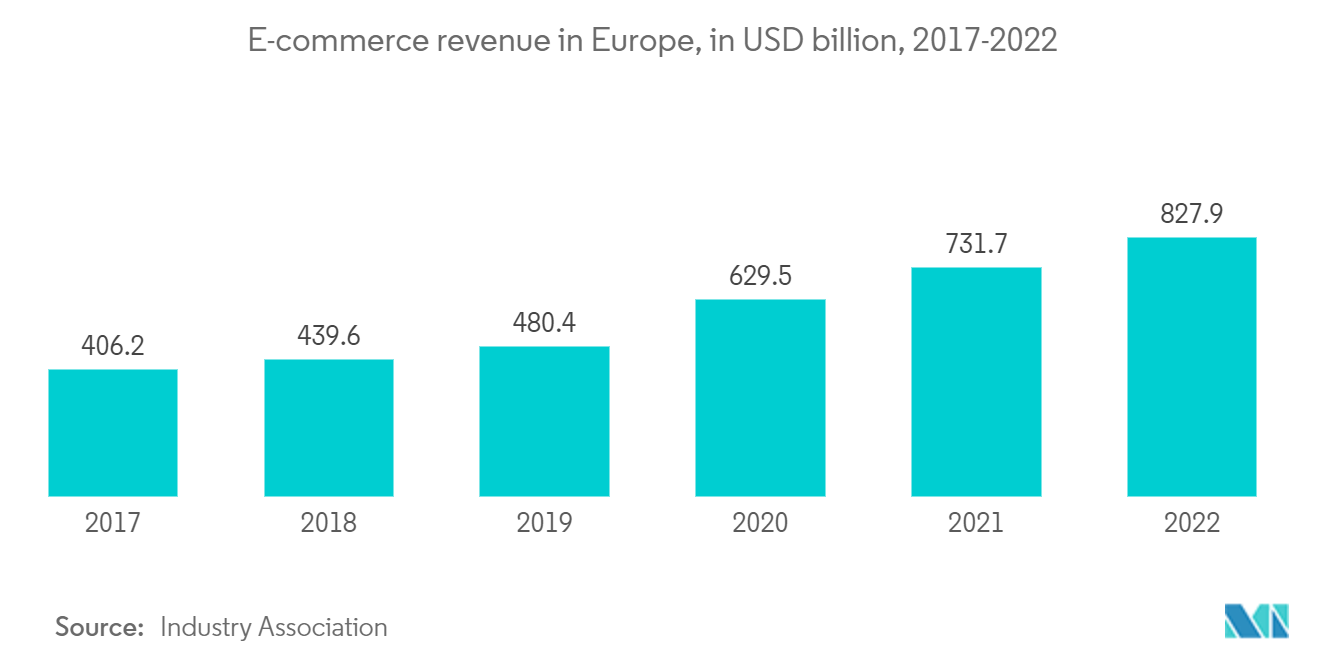
Impact of Brexit on the Logistics Market
The UK left the European Union (EU) after years of negotiations. Many experts say it could significantly affect Europe's supply chain and logistics sector. It will harm European trade.
Before Brexit, goods and supplies moved across Europe without much interruption, resulting in a smooth transition essential for the supply chain functioning. Post-Brexit, there will be economic, customs, and administrative changes, and additional charges and duties will be imposed on shipments. It will significantly affect the supply chain functioning.
The EU is the world's second-largest trading bloc, and Brexit will result in incremental costs in the supply chain. It will not only impact intra-Europe trade but also hugely affect the logistics industry in the region.
Road haulage is the dominant mode of freight transport within the UK. Most goods imported to and exported from the UK by road are handled by overseas haulers (with vehicles mostly registered in Poland, Ireland, and Romania). Conversely, the UK haulers account for 8% of the total haulage activity in the EU.
Those UK haulers could face several hurdles post-Brexit. Also, additional tariffs and customs clearance procedures cause delays in supply chains and increase costs for all transport modes.
The UK logistics companies operating through European ports will also lose the benefits they received while members of the EU. Similarly, other European maritime transport companies will adhere to new UK rules and regulations while shipping in ports in the country.
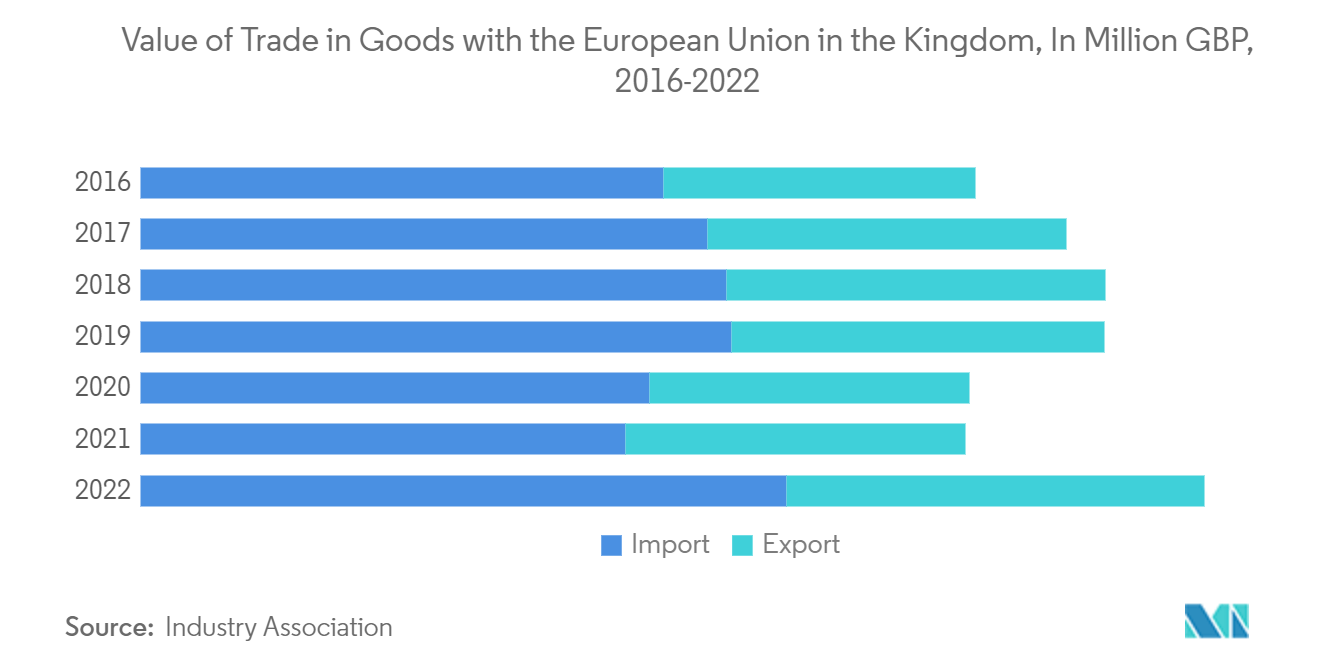
Europe FMCG Logistics Industry Overview
The Europe FMCG Logistics Market is highly competitive and fragmented, with many players. With Increasing FMCG sales worldwide, the demand for efficient logistics service providers also increased with the increasing sales. As FMCG products are essential, their demand will likely keep growing in the coming years. The opportunity for FMCG logistics service providers is expected to grow in the coming years. Some existing significant players in the market include - DHL Group, C.H. Robinson Worldwide Inc., Kuehne + Nagel International AG, Agility Logistics, CEVA Logistics, FedEx, XPO Logistics, Nippon Express, DB Schenker, Hellmann Worldwide Logistics and APL Logistics.
Europe FMCG Logistics Market Leaders
-
DHL Group
-
C. H. Robinson
-
Kuehne + Nagel International AG
-
Agility Logistics
-
CEVA Logistics
*Disclaimer: Major Players sorted in no particular order
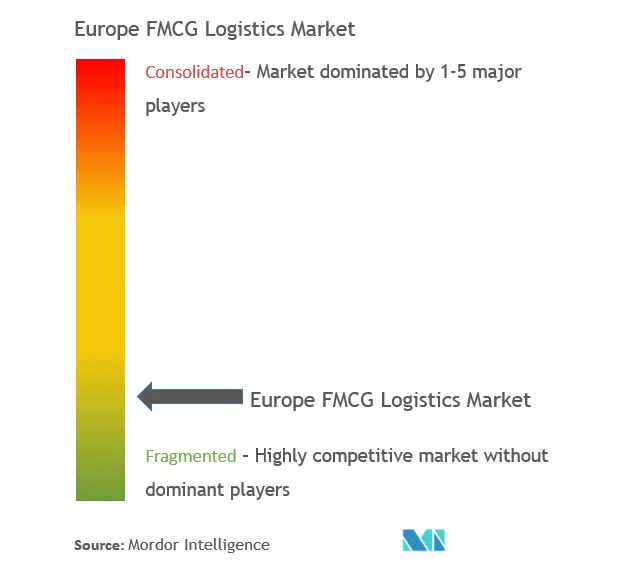
Europe FMCG Logistics Market News
- January 2023: CEVA Logistics announced the creation of a dedicated Finished Vehicle Logistics (FVL) organization as part of its integration with GEFCO. The move comes following the purchase of the French automotive logistics specialist in July 2022 by the CMA CGM Group. CEVA Logistics offers a full range of global logistics and supply chain services, including contract logistics and air, ocean, ground, and finished vehicle transport. With the GEFCO acquisition and integration, CEVA is now the largest France-based logistics company and a global leader in automotive logistics solutions.
- March 2022: DHL Parcel UK announced a new partnership with ZigZag, the technology platform specializing in e-commerce returns. ZigZag'snetwork of over 100 retailers, including Selfridges, GAP, and Superdry, can now access DHL's Just Right Returns service. It is a fast, convenient, and high-quality returns solution. ZigZagretailers can offer their customers the option to return their parcels at any of DHL's 3,500 service points nationwide for next-day collection, with returns delivered to the retailers the following day. The fast turnaround offered by DHL will appeal to retailers looking to get goods back on the shelves quickly through efficient returns handling.
Europe FMCG Logistics Market Report - Table of Contents
1. INTRODUCTION
- 1.1 Study Assumptions
- 1.2 Scope of the Study
2. RESEARCH METHODOLOGY
- 2.1 Analysis Methodology
- 2.2 Research Phases
3. EXECUTIVE SUMMARY
4. MARKET INSIGHTS
- 4.1 Current Market Scenario
- 4.2 Value Chain / Supply Chain Analysis
- 4.3 Technological Trends
- 4.4 Insights into E-Commerce Industry in the Region
- 4.5 Government Regulations and Initiatives
- 4.6 Insights on 3PL market and Courier, Express, and Parcel Mrkets in Europe
- 4.7 Impact of Covid-19 on FMCG Logistics Market
5. MARKET DYNAMICS
- 5.1 Drivers
- 5.2 Restraints
- 5.3 Opportunities
-
5.4 Industry Attractiveness - Porter's Five Forces Analysis
- 5.4.1 Bargaining Power of Suppliers
- 5.4.2 Bargaining Power of Consumers
- 5.4.3 Threat of New Entrants
- 5.4.4 Threat of Substitutes
- 5.4.5 Intensity of Competitive Rivalry
6. MARKET SEGMENTATION
-
6.1 By Service
- 6.1.1 Transportation
- 6.1.2 Warehousing, Distribution, and Inventory Management
- 6.1.3 Other Value-added Services
-
6.2 By Product Category
- 6.2.1 Food and Beverage
- 6.2.2 Personal Care
- 6.2.3 Household Care
- 6.2.4 Other Consumables
-
6.3 By Country
- 6.3.1 Germany
- 6.3.2 United Kingdom
- 6.3.3 Netherlands
- 6.3.4 France
- 6.3.5 Italy
- 6.3.6 Spain
- 6.3.7 Poland
- 6.3.8 Belgium
- 6.3.9 Sweden
- 6.3.10 Rest of Europe
7. COMPETITIVE LANDSCAPE
- 7.1 Market Concentration Overview
-
7.2 Company Profiles
- 7.2.1 DHL Group
- 7.2.2 C.H. Robinson Worldwide Inc.
- 7.2.3 Kuehne + Nagel International AG
- 7.2.4 Agility Logistics
- 7.2.5 CEVA Logistics
- 7.2.6 FedEx
- 7.2.7 XPO Logistics
- 7.2.8 Nippon Express
- 7.2.9 DB Schenker
- 7.2.10 Hellmann Worlwide Logistics
- 7.2.11 APL Logistics*
- *List Not Exhaustive
8. MARKET OPPORTUNITIES AND FUTURE TRENDS
9. APPENDIX
** Subject To AvailablityEurope FMCG Logistics Industry Segmentation
FMCG Logistics is the management of goods flow from one point of origin to the point of consumption to meet the customer requirement. FMCG logistics management focuses on the efficiency and effective management of daily activities concerning transporting daily usable goods from one place to another.
The Europe FMCG Logistics market is segmented by service (transportation, warehousing, distribution, inventory management, and other value-added services), product category (food and beverage, personal care, household care, and other consumables), and geography (Germany, United Kingdom, Netherlands, France, Italy, Spain, Poland, Belgium, Sweden and rest of Europe). The report offers market size and forecasts in value (USD billion) for all the above segments.
| By Service | Transportation |
| Warehousing, Distribution, and Inventory Management | |
| Other Value-added Services | |
| By Product Category | Food and Beverage |
| Personal Care | |
| Household Care | |
| Other Consumables | |
| By Country | Germany |
| United Kingdom | |
| Netherlands | |
| France | |
| Italy | |
| Spain | |
| Poland | |
| Belgium | |
| Sweden | |
| Rest of Europe |
Europe FMCG Logistics Market Research FAQs
How big is the Europe FMCG Logistics Market?
The Europe FMCG Logistics Market size is expected to reach USD 289.51 billion in 2024 and grow at a CAGR of 4.62% to reach USD 362.86 billion by 2029.
What is the current Europe FMCG Logistics Market size?
In 2024, the Europe FMCG Logistics Market size is expected to reach USD 289.51 billion.
Who are the key players in Europe FMCG Logistics Market?
DHL Group, C. H. Robinson, Kuehne + Nagel International AG, Agility Logistics and CEVA Logistics are the major companies operating in the Europe FMCG Logistics Market.
What years does this Europe FMCG Logistics Market cover, and what was the market size in 2023?
In 2023, the Europe FMCG Logistics Market size was estimated at USD 276.73 billion. The report covers the Europe FMCG Logistics Market historical market size for years: 2020, 2021, 2022 and 2023. The report also forecasts the Europe FMCG Logistics Market size for years: 2024, 2025, 2026, 2027, 2028 and 2029.
FMCG Logistics in Europe Industry Report
Statistics for the 2023 FMCG Logistics in Europe market share, size and revenue growth rate, created by Mordor Intelligence™ Industry Reports. FMCG Logistics in Europe analysis includes a market forecast outlook to 2029 and historical overview. Get a sample of this industry analysis as a free report PDF download.



